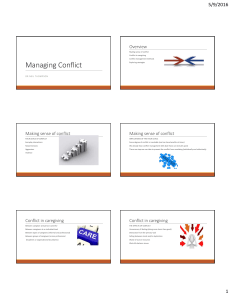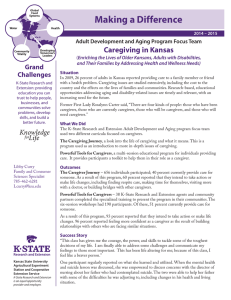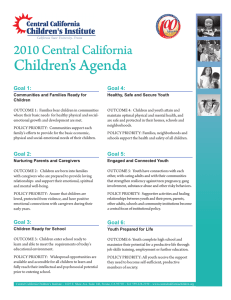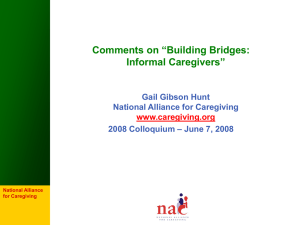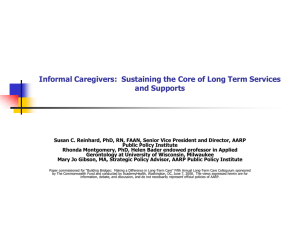INSIGHT on the Issues AARP Public Policy Institute
advertisement
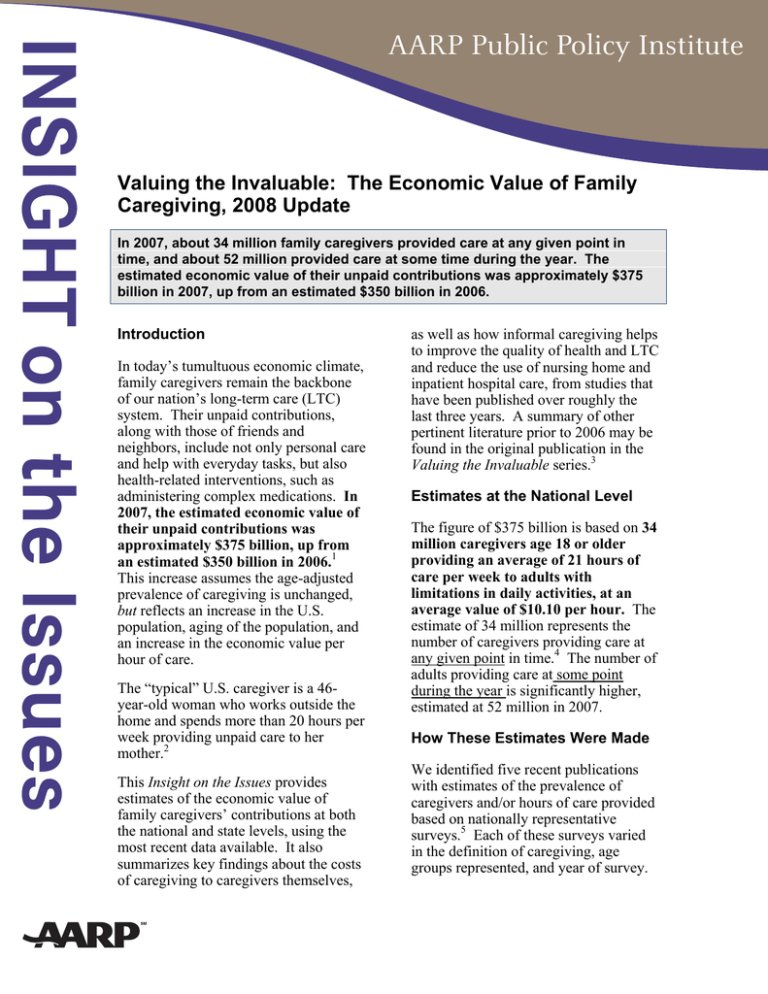
INSIGHT on the Issues AARP Public Policy Institute Valuing the Invaluable: The Economic Value of Family Caregiving, 2008 Update In 2007, about 34 million family caregivers provided care at any given point in time, and about 52 million provided care at some time during the year. The estimated economic value of their unpaid contributions was approximately $375 billion in 2007, up from an estimated $350 billion in 2006. Introduction In today’s tumultuous economic climate, family caregivers remain the backbone of our nation’s long-term care (LTC) system. Their unpaid contributions, along with those of friends and neighbors, include not only personal care and help with everyday tasks, but also health-related interventions, such as administering complex medications. In 2007, the estimated economic value of their unpaid contributions was approximately $375 billion, up from an estimated $350 billion in 2006.1 This increase assumes the age-adjusted prevalence of caregiving is unchanged, but reflects an increase in the U.S. population, aging of the population, and an increase in the economic value per hour of care. The “typical” U.S. caregiver is a 46year-old woman who works outside the home and spends more than 20 hours per week providing unpaid care to her mother.2 This Insight on the Issues provides estimates of the economic value of family caregivers’ contributions at both the national and state levels, using the most recent data available. It also summarizes key findings about the costs of caregiving to caregivers themselves, as well as how informal caregiving helps to improve the quality of health and LTC and reduce the use of nursing home and inpatient hospital care, from studies that have been published over roughly the last three years. A summary of other pertinent literature prior to 2006 may be found in the original publication in the Valuing the Invaluable series.3 Estimates at the National Level The figure of $375 billion is based on 34 million caregivers age 18 or older providing an average of 21 hours of care per week to adults with limitations in daily activities, at an average value of $10.10 per hour. The estimate of 34 million represents the number of caregivers providing care at any given point in time.4 The number of adults providing care at some point during the year is significantly higher, estimated at 52 million in 2007. How These Estimates Were Made We identified five recent publications with estimates of the prevalence of caregivers and/or hours of care provided based on nationally representative surveys.5 Each of these surveys varied in the definition of caregiving, age groups represented, and year of survey. Combining prevalence data from all five surveys, we classified caregivers by care recipient age, and estimated the number of caregivers in each of four age tiers (ages 18–59, 60–74, 75–84, and 85+) per person in the age group for each state. The economic value of caregiving was then calculated by (number of caregivers at any given time) x (hours of care per caregiver per year) x (economic value per hour) in each state. For a complete description of the methodology, please see www.aarp.org/research/housingmobility/caregiving/i13_caregiving.html. Table 1 Economic value per Hour Range of Estimates for the Economic Value of Caregiving in 2007, for Varying Prevalence & Cost Estimates Number of Caregivers What These Estimates Include These estimates include only adults currently providing care at any given point in time to adults with limitations in daily activities. Because of data limitations, the estimates do not include caregivers and care recipients under age 18; nor do they include caregivers who provide assistance to adults who have chronic health conditions but do not have a limitation in an activity of daily living (ADL) or instrumental activity of daily living (IADL).6 Low (29 million) Med. (34 million) High (41 million) High ($18.22 /hr) $570 billion $675 billion $800 billion Med. ($10.10 /hr) $315 billion $375 billion $445 billion Low ($6.64 /hr) $205 billion $245 billion $290 billion caregivers and economic value per hour. Depending on assumptions and data sources used, the total economic value of caregiving may be as high as $800 billion.8 How Much Is $375 Billion? Some benchmarks can help to put this figure in more meaningful context. The estimated $375 billion is: In addition, we used a relatively low estimate of the average value of family caregivers’ time, at about $10 per hour;7 yet family caregivers may engage in many types of activities, ranging from assistance with shopping to complex care coordination to health-related interventions, such as managing intravenous medications. Moreover, the “opportunity costs” of foregone wages and nonwage benefits such as health insurance or pension benefits are not included. It should be noted that $375 billion is a rough estimate, based on our best estimate of the number of caregivers and hours per year, and it is a somewhat conservative estimate. Table 1 gives the range of estimates, using high, medium, and low estimates of the number of 2 • More than total Medicaid spending in 2007, including both federal and state contributions for both medical and long-term care ($311 billion).9 • As much as the total sales of the world’s largest companies, including Wal-Mart Stores ($379 billion in 2007, the most of any company) and ExxonMobil ($359 billion).10 • Approaching total expenditures for the Medicare program ($432 billion in 2007).11 • More than $1,000 for every person in the United States (302 million people as of July 1, 2007).12 • About 2.7 percent of the U.S. gross domestic product ($13.8 trillion in 2007).13 $125 to more than $900 per capita, and in spending for HCBS, from about $50 to more than $400 per capita. Figure 1 Economic Value of Caregiving and Various Benchmarks, in Billions, 2007 Medicare Spending Total Sales of W al-Mart $379 Econ. Value of Caregiving $375 Medicaid Spending The economic value of caregiving exceeded total Medicaid LTC spending in all states, and was more than three times as high in 36 states. $432 Compared to Medicaid HCBS spending, the economic value of family caregiving was at least three times as high in all states, and more than 10 times as high in 19 states. $311 The Costs of Caregiving The costs of caregiving to caregivers themselves are more than a simple accounting of hours. They also include: State Variation The most important factor in determining the number of caregivers in each state is state population. However, caregiving prevalence also varies among states, reflecting differences in the age structure of the population, rates of disability and chronic health conditions, and cultural and economic factors. There is also significant variation in economic value per hour among states. Table 2 presents estimates of the number of caregivers, economic value per hour, and total economic value of caregiving in every state and the District of Columbia. Direct Out-of-Pocket Costs Caregivers to persons age 50 or older reported spending an average of $5,531 out-of-pocket in 2007. Long-distance caregivers had the highest annual expenses ($8,728), compared to coresident caregivers ($5,885) and those who cared for someone nearby ($4,570).15 Economic Insecurity Due to Changes in Work Patterns The loss of wages, health insurance and other job benefits, retirement savings, and Social Security benefits holds serious consequences for caregivers. More than one-third (37%) of caregivers to persons age 50 older reported quitting their job or reducing their work hours in 2007.16 Another recent study found that midlife women in the labor force who begin caregiving are more likely to leave the labor force entirely than to reduce their hours.17 Table 3 compares the total economic value of caregiving to three measures in each state: total Medicaid spending, Medicaid LTC spending, and Medicaid home- and community-based services (HCBS) spending.14 State-to-state variation in these ratios is mostly due to variation in state Medicaid spending. Total Medicaid spending ranges from less than $500 per capita in Nevada to more than $2,000 per capita in New York and the District of Columbia. Health Effects and Costs Caregivers are at risk of becoming “patients” themselves, according to a recent summary of decades of evidence States differ even more dramatically in Medicaid spending for LTC, from about 3 Table 2 Number of Caregivers and the Economic Value of Caregiving, by State, 2007 Number of Caregivers Total State Economic Total Value State At any At any time Population Value/Hour (millions) given time during the year Alabama Alaska Arizona Arkansas California Colorado Connecticut Delaware Dist. of Columbia Florida Georgia Hawaii Idaho Illinois Indiana Iowa Kansas Kentucky Louisiana Maine Maryland Massachusetts Michigan Minnesota Mississippi Missouri Montana Nebraska Nevada New Hampshire New Jersey New Mexico New York North Carolina North Dakota Ohio Oklahoma Oregon Pennsylvania Rhode Island South Carolina South Dakota Tennessee Texas Utah Vermont Virginia Washington West Virginia Wisconsin Wyoming United States 4,630,000 683,000 6,340,000 2,830,000 36,600,000 4,860,000 3,500,000 865,000 588,000 18,250,000 9,540,000 1,283,000 1,499,000 12,850,000 6,350,000 2,990,000 2,780,000 4,240,000 4,290,000 1,317,000 5,620,000 6,450,000 10,070,000 5,200,000 2,920,000 5,880,000 958,000 1,775,000 2,570,000 1,316,000 8,690,000 1,970,000 19,300,000 9,060,000 640,000 11,470,000 3,620,000 3,750,000 12,430,000 1,058,000 4,410,000 796,000 6,160,000 23,900,000 2,650,000 621,000 7,710,000 6,470,000 1,812,000 5,600,000 523,000 302,000,000 570,000 74,000 610,000 360,000 4,000,000 540,000 370,000 105,000 57,000 1,800,000 1,330,000 113,000 162,000 1,490,000 720,000 300,000 270,000 530,000 560,000 153,000 600,000 690,000 1,280,000 590,000 460,000 590,000 111,000 177,000 280,000 147,000 980,000 210,000 2,200,000 1,110,000 56,000 1,320,000 380,000 410,000 1,390,000 114,000 580,000 87,000 780,000 2,800,000 340,000 55,000 910,000 640,000 280,000 590,000 55,000 34,000,000 4 860,000 117,000 920,000 550,000 6,100,000 840,000 560,000 158,000 87,000 2,700,000 2,000,000 169,000 250,000 2,300,000 1,100,000 450,000 410,000 800,000 850,000 230,000 920,000 1,040,000 1,940,000 900,000 690,000 890,000 167,000 270,000 430,000 220,000 1,470,000 320,000 3,300,000 1,690,000 83,000 1,990,000 570,000 620,000 2,100,000 171,000 880,000 130,000 1,180,000 4,200,000 520,000 83,000 1,390,000 970,000 420,000 890,000 84,000 52,000,000 $8.49 $13.10 $10.50 $8.80 $11.05 $11.04 $12.37 $11.31 $10.82 $9.89 $9.07 $11.92 $9.13 $10.60 $9.91 $10.25 $9.24 $9.51 $8.13 $11.18 $10.12 $11.86 $10.41 $11.11 $8.18 $9.84 $9.53 $10.48 $10.81 $11.55 $11.16 $9.36 $10.61 $9.63 $9.74 $9.92 $9.15 $10.91 $10.39 $11.94 $8.99 $9.87 $9.23 $8.76 $9.68 $11.45 $9.38 $11.43 $8.23 $10.32 $9.84 $10.10 $5,200 $1,050 $6,900 $3,500 $48,000 $6,500 $4,900 $1,280 $670 $19,200 $13,000 $1,450 $1,600 $17,100 $7,800 $3,400 $2,700 $5,400 $4,900 $1,840 $6,600 $8,800 $14,400 $7,100 $4,000 $6,300 $1,140 $2,000 $3,300 $1,830 $11,800 $2,100 $25,000 $11,600 $580 $14,200 $3,700 $4,800 $15,600 $1,470 $5,700 $920 $7,800 $26,000 $3,500 $680 $9,200 $7,900 $2,500 $6,600 $580 $375,000 Table 3 Ratio of Economic Value of Caregiving to Medicaid Spending, by State, 2007 Ratio of Economic Value of Caregiving to State Total Medicaid Medicaid LTC Medicaid HCBS spending spending * spending * Alabama Alaska Arizona** Arkansas California Colorado Connecticut Delaware Dist. of Columbia Florida Georgia Hawaii Idaho Illinois Indiana Iowa Kansas Kentucky Louisiana Maine Maryland Massachusetts Michigan Minnesota Mississippi Missouri Montana Nebraska Nevada New Hampshire New Jersey New Mexico New York North Carolina North Dakota Ohio Oklahoma Oregon Pennsylvania Rhode Island South Carolina South Dakota Tennessee Texas Utah Vermont** Virginia Washington West Virginia Wisconsin Wyoming United States 1.27 1.10 1.04 1.09 1.55 2.19 1.13 1.29 0.50 1.40 1.81 1.30 1.45 1.35 1.51 1.27 1.27 1.18 1.01 0.87 1.19 0.86 1.57 1.15 1.23 0.95 1.56 1.30 2.65 1.53 1.32 0.82 0.61 1.19 1.13 1.09 1.10 1.65 0.98 0.84 1.36 1.49 1.09 1.27 2.51 0.65 1.86 1.38 1.13 1.31 1.35 1.20 4.2 3.1 n/a 3.5 5.0 5.8 2.2 4.4 1.8 4.6 8.7 3.9 4.3 5.7 4.7 2.9 3.1 4.2 3.7 2.8 3.8 3.0 6.3 2.6 3.7 4.0 3.9 3.2 10.2 3.4 3.4 3.0 1.4 4.0 1.9 3.0 3.4 4.5 2.5 2.6 5.7 3.6 3.8 5.3 9.8 n/a 5.7 4.3 3.0 3.1 2.9 3.7 14.6 5.0 n/a 11.7 9.1 11.3 6.1 12.3 5.4 13.5 22.8 9.8 9.9 18.1 14.0 7.7 5.8 13.8 10.1 5.5 9.3 7.7 18.9 4.1 29.3 8.9 8.7 8.4 22.5 8.7 11.6 4.1 3.0 8.9 7.3 9.9 7.9 6.2 8.9 5.7 16.4 9.2 12.8 12.5 25.3 n/a 14.5 6.9 7.3 6.8 5.3 8.9 * In this table, LTC and HCBS spending include home health. Spending data are from B. Burwell, K. Sredl, and S. Eiken, Medicaid Long Term Care Expenditures FY 2007 (Thomson Reuters, 2008). ** Both Arizona and Vermont operate large managed 5 care programs through 1115 waivers, so comparable data on Medicaid LTC and HCBS spending are not available for these states. on the physical and mental health effects of caregiving.18 The greater the intensity in the type or quantity of assistance provided, the greater the magnitude of the health effects, which are largely due to chronic stress.19 Not surprisingly, problems paying medical bills and medical debt are more frequent among caregivers than among noncaregivers. adult children, are older, less educated, and in worse health than those not accompanied. The presence of these companions during physician visits facilitates communication and increases patient satisfaction.26 The role of family caregivers as critical partners with professionals in the care of patients with chronic illnesses, along with the need for better communication with and support of family caregivers, has been established.27 Interventions that focus on the roles of family caregivers during care transitions show positive results, ranging from better patient outcomes in functional status and quality of life to reduced rehospitalizations.28,29 For example, better discharge planning involving family caregivers during transitions from hospital to home may not only improve quality of care but also help to avert early hospital readmission among Medicare beneficiaries.30 Effects on the Health and Long-Term Care Systems Long recognized as the foundation of the nation’s LTC system, family caregivers are also critical resources in the nation’s health care system. Both the aging of the population and shortages of health and LTC workers, including nurses and paraprofessionals, are placing additional pressure on health and LTC systems.20 Trends toward shorter hospital stays and greater reliance on home- and community-based care rather than nursing home care continue. And the increasing number of veterans with traumatic brain injuries and other severe disabilities can present lifelong challenges to family members, including older parents as well as spouses. Conclusions For both ethical and economic reasons, it is essential to prevent family caregivers from being overwhelmed by the demands placed upon them. The cost of funding more services and supports for caregivers is minute compared to the value of their unpaid contributions. Moreover, caregivers help to contain health and long-term care costs by delaying or preventing the use of nursing home care and hospital inpatient care. The following policy recommendations could all be implemented at small fractions of the value of unpaid caregivers’ contributions. These recommendations apply to policies at both the federal and state levels. Evidence that family caregiver support delays or prevents the use of nursing homes continues to accumulate.21 Recent analysis also provides support for initiatives to reduce stress among persons caring for chronically disabled elders as a strategy to reduce or defer nursing home entry.22 People who have family caregivers tend to have shorter hospital stays,23 while the absence of a family caregiver has been linked to hospital readmissions.24 Informal care by adult children reduces Medicare inpatient expenditures of single older persons, as well as expenditures for home health and skilled nursing facility care.25 The 39 percent of Medicare beneficiaries 65 or older who are accompanied to routine medical visits, most commonly by spouses or • 6 Implement “family-friendly” workplace policies that include flextime and telecommuting, referral to supportive services, and caregiver support programs in the workplace. • Assess family caregivers’ own needs, such as through publicly funded home- and community-based service programs, and provide or refer them to supportive services. • Provide paid leave to permit caregivers to care for an ill child, spouse, or parent, including expanding the Family and Medical Leave Act (FMLA) to provide paid leave and to cover more workers for longer periods.31 • Provide adequate funding for respite programs, including the Lifespan Respite Care Act, which was enacted in 2006 but for which no funding has yet been provided. • Provide financial assistance for family caregivers, such as a tax credit for caregiving. A $3,000 tax credit, the amount that would be provided as part of several federal legislative proposals, would help to offset some of the direct expenses of eligible caregivers. Many of these caregivers would still bear high costs associated with caregiving, including lost wages and employment benefits, lower retirement benefits, poorer health status, and higher medical expenses of their own. Encourage nurses, social workers, and other health professionals to provide greater support to family caregivers and to engage them as partners in care. 1 See M. J. Gibson and A. Houser, Valuing the Invaluable: A New Look at the Economic Value of Family Caregiving, AARP Public Policy Institute Issue Brief IB-82 (Washington, DC: AARP, June 2007); and A. Houser and M. J. Gibson, Valuing the Invaluable: A New Look at State Estimates of the Economic Value of Family Caregiving (Data Update), AARP Public Policy Institute Data Digest DD158R (Washington, DC: AARP, November 2007). This Insight on the Issues updates the estimates of the number of caregivers and economic value of caregiving. Expand funding for the National Family Caregiver Support Program (NFCSP). The total budget for NFCSP funding, including the funding for Native American Caregiver Support, is $166 million for fiscal year 2008. This represents less than one-twentieth of 1 percent of the economic value of caregivers’ contributions. • • • 2 Caregiving in the U.S. (Bethesda, MD: National Alliance (NAC) and Washington, DC: AARP, 2004). 3 See Gibson and Houser (June 2007). 4 We considered surveys that asked whether someone was “currently providing care” or “providing care within the last month” to be equivalent “any given point in time” measures. 5 The five publications are NAC and AARP, Caregiving in the U.S. (2004); P. Arno, Estimated Prevalence and Economic Value of Family Caregiving, by State (2004) (Kensington, MD: National Family Caregivers Association & San Francisco, CA: Family Caregiver Alliance, 2006); R. W. Johnson and S. G. Schaner, Many Older Americas Engage in Caregiving Activities (Washington, DC: Urban Institute, 2005); R. W. Johnson and J. M. Wiener, A Profile of Frail Older Americans and Their Caregivers, (Washington, DC: Urban Institute, 2006); and S. L. McKune, et al., Caregiving: A National Profile and Assessment of Caregiver Services and Needs (Americus, GA: Rosalynn Carter Institute, 2006). 6 ADLs include bathing, dressing, and eating; IADLs include managing medications or finances. Due to data limitations, the estimates do not include persons providing care to children under 18 with disabilities, caregivers under age 18 providing care to adults, or grandparents providing care for children under 18. 7 The value per hour was estimated at the state level as a weighted average of the state minimum wage (w), home health aide median wage (x), and average private pay hourly rate for hiring a home health aide(y), given by (w+x+0.5y)/2.5 Recognize and support the role of family caregivers in chronic care coordination programs and care transitions. 7 8 The high and low estimates of the number of caregivers are the average of the two highest and two lowest of the five data sources used to estimate prevalence. The high estimate for the value per hour uses the average private pay hourly rate for hiring a home health aide, and the low estimate uses the state minimum instead of the weighted average in note 7. Care Policy, U.S. Department of Health and Human Services, January 26, 2007. G. Picone, R. M. Wilson, and S. Chous, Analysis of Hospital Length of Stay and Discharge Destination Using Hazard Functions with Unmeasured Heterogeneity, Heath Economics 12(12):1021–1034 (2003). 9 B. Burwell, K. Sredl, and S. Eiken, Medicaid Long Term Care Expenditures FY 2007 (New York, NY: Thomson Reuters, 2008). 24 E. C. Schwarz, Identification of Factors Predictive of Hospital Readmissions for Patients with Heart Failure, Heart & Lung 32:88–99 (2003). 10 Forbes.com, Special Report: The Global 2000, www.forbes.com/lists/2008/18/biz_2000global08_The -Global-2000_Sales.html. 25 C. H. Van Houten and E. C. Norton, Informal Care and Medicare Expenditures: Testing for Heterogeneous Treatment Effects, Journal of Health Economics 27:134–156 (2008). 11 Center for Medicare and Medicaid Services, 2008 Medicare Trustees report, www.cms.hhs.gov/ReportsTrustFunds/ 26 J. L. Wolff and D. L. Roter, Hidden in Plain Sight: Medical Visit Companions as a Resource for Vulnerable Older Adults, Archives of Internal Medicine 168(13):1409–1415 (2008). 12 U.S. Census Bureau, Population Estimates Program, Table DP-1: General Demographic Characteristics: July 2007. 27 S. C. Reinhard, et. al., Supporting Family Caregivers in Providing Care, in Patient Safety and Quality: An Evidence-Based Handbook for Nurses, ed. R. G. Hughes, Vol. 08-0043 (Rockville, MD: Agency for Healthcare Research and Quality, 2008). 13 U.S. Department of Commerce, Bureau of Economic Analysis, NIPA table 1.1.5, 2007-A. 14 In this report, LTC and HCBS spending include home health services. 28 M. Naylor, and S. Keating, Transitional Care, in Reinhard, Danso-Brooks, and Kelly, eds. (2008), pp. 58–63. 15 Family Caregivers – What They Spend, what They Sacrifice: The Personal Financial Toll of Caring for a Loved One. (Minnetonka, MN: Evercare & Bethesda, MD: NAC, 2007). 16 29 E. A. Coleman and S. Chalmers, The Care Transitions Intervention: Results of a Randomized Controlled Trial. Archives of Internal Medicine 166:1822–1828 (2006). Ibid. 17 E. K. Pavalko and K. A. Henderson, Combining Care Work and Paid Work: Do Workplace Policies Make a Difference? Research on Aging, 28(3):359– 374 (May 2006). 30 I. Arbaje, et al., Postdischarge Environmental and Socioeconomic Factors and Likelihood of Early Hospital Readmission Among Community-Dwelling Medicare Beneficiaries, The Gerontologist, 48(4): 495–504 (2008). 18 S. Reinhard, A. Danso-Brooks, and K. Kelly, eds., State of the Science: Professional Partners Supporting Family Caregivers, American Journal of Nursing, 108(9 supplement) (September 2008), www.nursingcenter.com/ajnfamilycaregivers. 31 FMLA allows individuals who work for employers with 50 or more employees to take up to 12 weeks of unpaid leave to care for themselves, a child, spouse, or parent in the case of serious illness. 19 R. Schulz and P. R. Sherwood, Physical and Mental Health Effects of Family Caregiving, in Reinhard, Danso-Brooks, and Kelly, eds. (2008), pp. 12–26. Insight on the Issues 13, November, 2008 20 Institute of Medicine, Retooling for an Aging America (Washington, DC: The National Academies Press, 2008). Written by Ari Houser and Mary Jo Gibson AARP Public Policy Institute, 601 E Street, NW, Washington, DC 20049 www.aarp.org/ppi 202-434-3890, ppi@aarp.org © 2008, AARP. Reprinting with permission only. 21 M. S. Mittleman, et al., Improving Caregiver Wellbeing Delays Nursing Home Placement of Patients with Alzheimer’s Disease, Neurology 67(9):1592– 1599 (2006). 22 B. Spillman and S. Long, Does High Caregiver Stress Lead to Nursing Home Entry? paper prepared for the Office of Disability, Aging, and Long-Term 8 INSIGHT on the Issues 23
